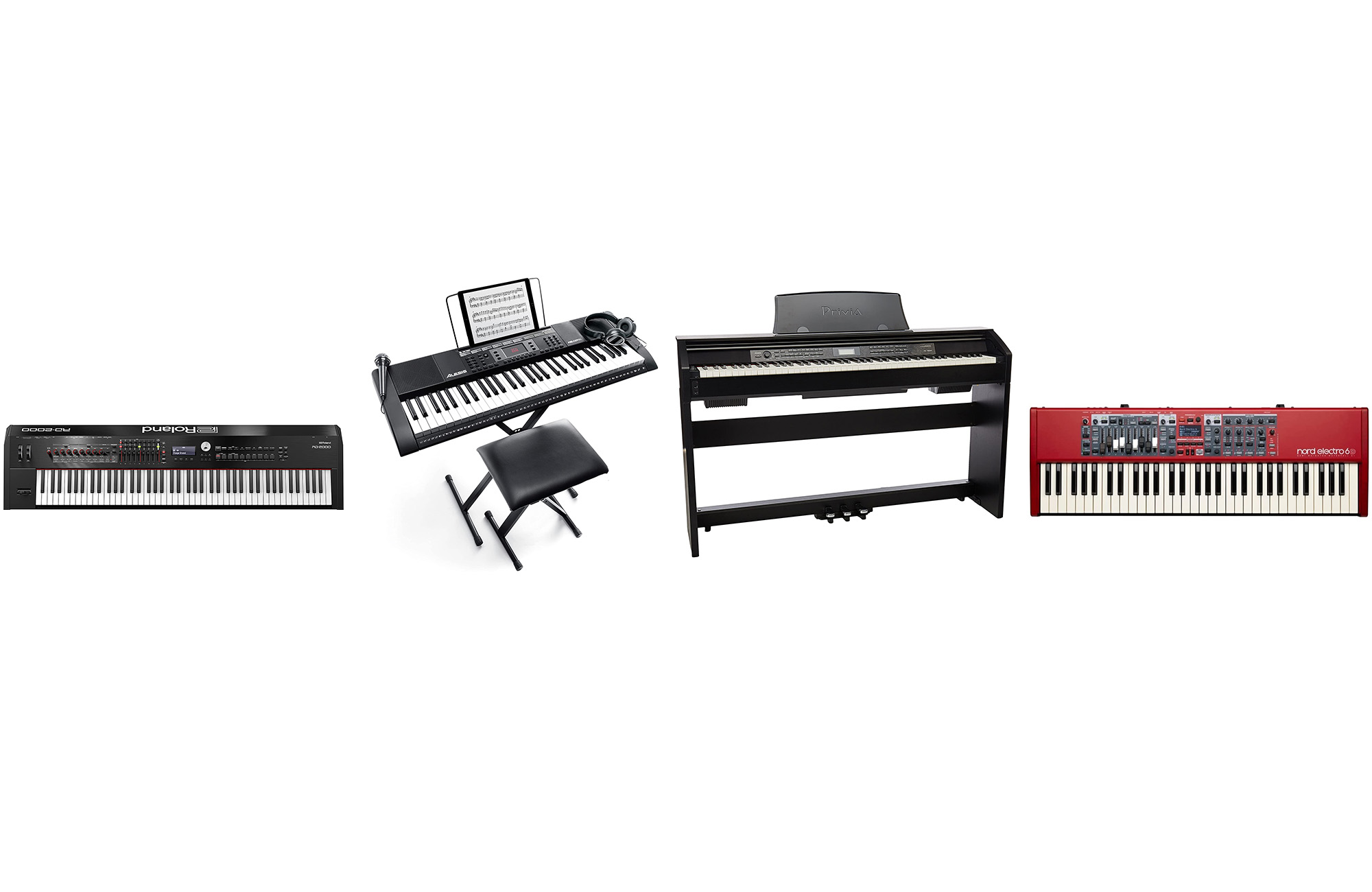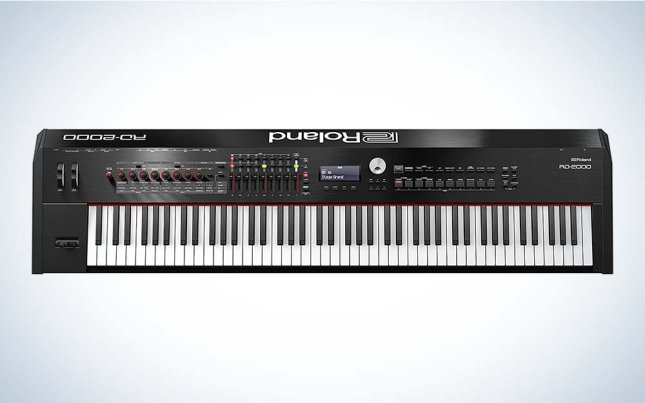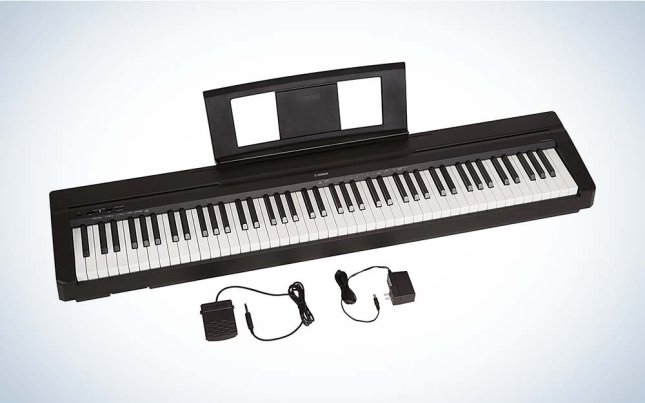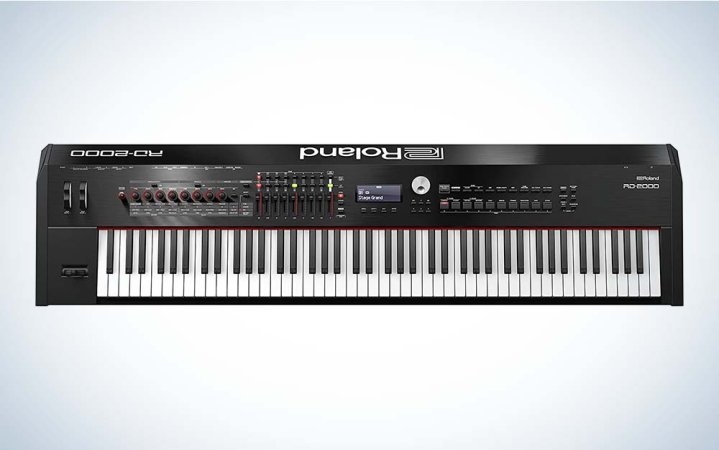We may earn revenue from the products available on this page and participate in affiliate programs. Learn more ›

Did you know that the predecessor to the electric piano, the acoustic piano (also known as the pianoforte), has been around since 1700? Bartolomeo Cristofori of Padua, Italy, is credited for its design, which evolved from the harpsichord. You can still view one of his surviving models at the Metropolitan Museum of Art in New York City. Playing a piano can feel like you have an entire orchestra at your fingertips, but the acoustic version has some serious drawbacks. These heavy and unwieldy instruments are notorious for being more expensive to move than their worth, and the trope of a falling piano endures in cartoons and sitcoms. Electric pianos are a welcome alternative for musicians across all genres who want to make music from anywhere and enhance their skills in ways that aren’t possible on a 500-pound baby grand. Here’s what to look for as you choose one of the best electric pianos for your lifestyle.
- Best overall: Roland RD-2000
- Best for beginners: Alesis Melody 61
- Best for stage: Nord Electro 6D 61
- Best for songwriters and teachers: Casio PX-780 Privia
- Best budget: Yamaha P71
How we chose the best electric pianos
Brand: I selected quality options from brands my colleagues and I trust to use on stage and in our home studios. I placed a high value on the top brands used by pros, even when selecting models more suitable for beginners.
Value: For each model chosen, I evaluated use cases for prospective buyers. For example, a true beginner who will graduate to a larger keyboard or piano over time will have different parameters for what makes a good buy than would a pianist on a budget looking for an electric piano that sounds and feels like its acoustic counterpart.
Size: For performers seeking a substitute for an acoustic piano in their home or home studio, I selected full-size 88-key instruments with less focus on their physical footprint. For performers who take their keyboard to gigs, I evaluated weight, versatility, and durability.
Special features: I did not consider special features as a bonus or extra that would make one model preferable over another. Instead, for each special feature of a particular model, such as extensive sound libraries, play-along songs, or access to educational materials, I assessed their purpose and value to different kinds of musicians before making my choices.
The best electric pianos: Reviews & Recommendations
As a professional musician, I’ve combined personal experience with the type of equipment my colleagues and I use, as well as research into brands and models carried by reputable stores, to identify the following electric pianos—a selection of digital pianos designed as instruments for creating art, as opposed to toys.
Best overall: Roland RD-2000
Best overall
Roland RD-2000
Pros
- Two sound engines (V-Piano Technology and SuperNATURAL)
- Multiple controllers from sliders to a modulation wheel
- Multiple connectors from MIDI to USB
- Weighs just under 48 pounds
Cons
- Must be connected to speakers or used with headphones
Why it made the cut: We’re excited about the Roland RD-2000 because of its versatility in delivering weighted piano action along with hundreds of sounds and ample effects controls.
Specs
- Number of keys: 88
- Dimensions: 55.6 by 14.5 by 5.6 inches
- Built-in speakers: No
Roland is known for designing and manufacturing pianos. The Roland RD-2000 launched in 2017 as the brand’s next-generation stage piano following the success of the RD-1000, which debuted in 1986.
Stage pianos are designed first for live performances where PA systems are the amplification method preferred over built-in speakers. However, we think that the overall combination of features in this model outweighs the small hassle of hooking the RD-2000 up to external speakers when you’re at home—or just using it with headphones.
Piano nerds will love that the two independent sound engines give you access to classic acoustic and electric Roland piano sounds (you can even go retro with the RD-1000 sound), plus hundreds of others. A zone-mapping feature makes it possible to play and control internal sounds of the piano at the same time as you control synth sounds in a DAW (digital audio workstation).
There’s a bit of a learning curve to take advantage of all the customization tools, but the opportunities for personal expression are enormous. Expansion slots for additional sounds keep your gear relevant to current sonic trends and add longevity to your purchase.
Best for beginners: Alesis Melody 61
Best for beginners
Alesis Melody 61
Pros
- 300 sounds from strings to brass
- 300 built-in rhythms for effortless accompaniment
- Comes with a 3-month subscription to Skoove online piano courses
- Includes essential accessories from a stand to a microphone
Cons
- Non-weighted keys
- No sustain pedal input
Why it made the cut: The Alesis Melody 61 is a fantastic entry-level choice to develop your skills at playing and songwriting right out of the box without breaking your budget.
Specs
- Number of keys: 61
- Dimensions: 17 x 10.9 x 40 inches
- Built-in speakers: Yes
Alesis is part of the inMusic portfolio of brands, which includes M-Audio and Akai. The Melody 61 is part of the company’s line of portable keyboards, which range from 32-key to 61-key models. Suppose you’re buying a digital piano solely to learn how to play and perform. We recommend investing in an 88-key piano with weighted keys instead (like the Yamaha P71, our budget pick below). However, for anyone who wants to get into the basics of music performance, songwriting, or arranging, this 61-key model offers a range of possibilities.
One of the biggest obstacles to starting a new hobby or sticking to a practice routine is the time it takes to get set up with the right gear. The Melody 61 already eliminates many barriers to getting started as it comes with a piano bench, stand, and microphone, plus access to Skoove’s online piano courses for three months (which include basic skill development and songs you can play along with).
We love that you can hear your piano playing and vocals through the built-in speakers when using the microphone, so once you learn a few basic chords, you are ready to compose an original song. You can also use the rhythmic accompaniment function to provide a beat to play along with and trigger the keyboard to play chords on those beats for a richer harmonic experience.
A record button allows you to play back your creations, although the save function lasts only while the piano is turned on. If you’re feeling shy or don’t want to disturb housemates or neighbors, plug in the included headphones to override the external speakers.
Best for stage: Nord Electro 6D 61
Best for stage
Nord Electro 6D 61
Pros
- Semi-weighted keys with waterfall tips ideal for organ and synth techniques
- 512 MB memory for the Nord Sample Library
- Iconic organ simulations from the Hammond B3 to the Farfisa
- Vintage 122 Rotary Speaker simulation (aka a Leslie)
Cons
- Lacks full 88 keys
- Must be connected to speakers or used with headphones
Why it made the cut: At just under 18 pounds, the Nord Electro 6D 61 is extra-portable and can transform you into a pianist, an organist, or a synth player depending on your mood.
Specs
- Number of keys: 61
- Dimensions: 35.4 x 3.8 x 11.7 inches
- Built-in speakers: No
Handmade in Sweden by Clavia Digital Musical Instruments AB, the Nord keyboards’ signature red color can be spotted on arena stages or in the dimly lit corner of your favorite underground music club. The first Nord Electro was released in 2001, and the Nord Electro 6 is the latest iteration. We chose the Nord Electro 6D 61 over the Nord Electro 6 HP 73-key model because of the waterfall tips on the keys, which are slightly rounded and well-suited to synth and organ techniques, and also because the slightly smaller keyboard size makes it even more portable.
Many digital pianos are designed as alternatives to acoustic pianos, with a range of sampled instrument sounds but few controls. In contrast, the Nord Electro 6D is like having a piano plus some of the most striking organ and synth sounds rolled into a single piece of equipment. The 6D (as opposed to the HP) also has physical drawbars (a type of slider) that mimic a real organ.
While there is a MIDI input/output, the vast amount of built-in controls can keep you (and your audience) entertained without ever cracking open your laptop. In addition to panning, flanging, ring modulator, and chorusing effects, you can also control multiple reverb types to make it drier or wetter. Amp simulators allow you to manipulate drive and compression, and every Hammond B3 fan will delight in mimicking the unmistakable sounds of a Leslie speaker.
Best for songwriters and teachers: Casio PX-780 Privia
Best for songwriters and teachers
Casio PX-780 Privia
Pros
- Tri-sensor scaled hammer action keyboard17-track recorder
- Can be used as a MIDI controller for iPad with Apple’s Camera Connection Kit
- Duet mode
Cons
- At nearly 90 pounds, it’s not very portable
Why it made the cut: We chose the Casio PX-780 because of its nice balance between expressive qualities and special features that educators and composers will enjoy, all for less than a grand.
Specs
- Number of keys: 88
- Dimensions: 59 x 16 x 17 inches
- Built-in speakers: Yes
Whether or not you grew up in the ’80s or are just vaguely familiar with the influential decade of hair bands and hanging out at the mall, you may associate Casio keyboards with quirky and cheesy digital sounds. You wouldn’t be wrong—the ’80s CK-200 was a combination piano and boom box—but, in the 21st century, the Japanese electronics company has many digital pianos suitable for serious musical artists.
To begin with, the PX-780 Privia has a full-size keyboard, and three built-in sensors capture how you strike each key to approximate the sound you would get if you were playing a grand piano with hammered strings. Coupled with Casio’s own AiR (Acoustic and Intelligent Resonator) processor technology, players can get a nice amount of nuance and realism from the sound.
Songwriters can take advantage of 17-track recording to layer piano, strings, bass, drums, and more, with the ability to access your pre-recorded mixes live on stage. You can even punch in to re-record part of a track and record your song to a USB drive as a .WAV file.
Teachers of beginners will enjoy duet mode, where you can sit side by side and each access the same note range (a little more than one octave below middle C and a little more than two octaves above) as if the piano is two identical 44-key segments. Teachers may also enjoy introducing students to recording and production basics to create demos of their progress for family and friends.
Best budget: Yamaha P71
Best budget
Yamaha P71
Pros
- Fully weighted keys
- Can combine two voices to play together when keys are struck
- Metronome
- Weighs just 25 pounds
Cons
- Only 10 sampled voices (i.e., grand piano or strings)
- Does not store recordings
Why it made the cut: The Yamaha P71 stands out in the market because of its no-frills focus on pianists who want a well-priced instrument that sounds and feels like an acoustic piano but can be used with headphones when the neighbors are home.
Specs
- Number of keys: 88
- Dimensions: 52.25 x 11.5 x 6 inches
- Built-in speakers: Yes
Yamaha is a revered music company that has been around for more than 130 years, with a roster of famous artists who play their pianos that ranges from pop icon Burt Bacharach to singer-songwriter Sara Bareilles and jazz star Gerald Clayton. The Yamaha P71 is an entry-level model for the company in terms of price. Still, their proprietary Graded Hammer Standard (GHS) technology means that pressing keys on the low end of this piano will have a heavier feel than pressing keys on the high end, like their acoustic counterpart.
As you might guess, Yamaha’s AWM (Advanced Wave Memory) sampling process uses Yamaha acoustic pianos to deliver high-quality sounds. Practice your technique at home with or without headphones, and then take advantage of the lightweight body and built-in speakers to take it to your live gig.
This piano has just 10 sampled sounds to play with (including harpsichord and vibraphone), does not have a built-in memory for recording, and doesn’t offer chord arpeggiation or rhythms for you to play along. However, a USB out port allows you to configure your MIDI to use the piano to record into a DAW or control virtual instruments and plug-ins.
It’s important to note that the P71 is a model exclusively available on Amazon, and according to Yamaha, it has no functional differences from their popular P-45 model. This means you may be able to get it at a better price than its twin sold elsewhere, but it’s smart to verify at the time of purchase.
Things to consider before buying an electric piano
These important factors will help you quickly narrow down your options from the immensely wide range of digital pianos on the market:
Space: When choosing an electric piano, you’ll definitely want to consider where you’re going to put it and whether or not you’ll want to move it regularly. A rectangular shape coupled with a lack of strings and hammers makes these pianos considerably easier to find room for in your home studio or living area than the average upright or baby grand. However, the weight and other dimensions of the piano itself are just a starting point. You should also factor in a piano stand to get your equipment to the right height, a piano bench set up at a distance that allows you to sit comfortably at the keys, and any extra lighting or other audio gear you’ll want to have at hand as you play.
Musical focus: Your musical focus should be one of the first things you identify before selecting an electric piano. Are you a performer, composer, producer, accompanist, or all of the above? Do you play all styles of music, or are you in a live band where you’ll want access to a variety of piano, organ, and synth sounds in one instrument? An ideal choice will have a balance between essentials and special features you’ll want to use regularly.
Feel: One of the most important questions to ask yourself about purchasing an electric piano is whether or not you are buying it primarily as an alternative to an acoustic piano. If so, you’ll want to select models with weighted keys and choose keyboards with a full 88 keys if you regularly use the full range of the piano in the music you write and play. Feel is subjective, so be aware that just because a favorite musician likes one model doesn’t mean it will be the right choice for you.
FAQs
The sounds of a digital keyboard are created by sampling acoustic instruments. Acoustic “real” pianos vary greatly in tone among different models (i.e., grand vs. upright), and the technique and expression of individual performers also impact the sound on many levels. As a consequence, higher quality samples that capture the nuances of a key-triggered hammer striking a piano string will create a more realistic-sounding piano (i.e., how it sounds when a key is struck forcefully vs. a softer attack, or what a staccato or short strike sounds like vs. a full chord pressed down slowly). In addition to great samples, top-quality digital pianos will be able to calibrate each player’s individual approach to the corresponding acoustic piano samples, so your percussive left-hand comping action hits as hard through the speakers as you’re hitting the keys.
Absolutely. However, you should know that the key weight and feel of different models, the key size, and the number of keys determine how effectively you can transfer your skills to an acoustic piano. Some musicians who use a digital piano to compose or play casually will never need to buy an acoustic piano to reach their musical goals. Other musicians using a digital piano to practice outside of an environment where they have access to an acoustic piano will want to ensure their digital piano has a full 88 keys and feels as close as possible to the pianos they play as a performer.
Your musical background and skill level, stylistic preferences, and whether you’ll be using it at home or onstage are all important factors to consider. There isn’t a “one-size-fits-all” approach to purchasing this instrument, and you may find that your preference for different types of digital pianos changes over time.
Final thoughts on the best electric pianos
- Best overall: Roland RD-2000
- Best for beginners: Alesis Melody 61
- Best for stage: Nord Electro 6D 61
- Best for songwriters and teachers: Casio PX-780 Privia
- Best budget: Yamaha P71
Taking your time to know what’s on the market and understand the benefits of various features makes a difference when choosing an instrument that can be a cathartic outlet for individual expression. We chose the Roland RD-2000 because it resonated with many of our criteria, from realistic sounds to portability and versatility. However, this doesn’t mean it’s the best choice for you right now. Even a small investment in the Alesis Melody 61 could be the perfect catalyst for an exciting journey as a songwriter or performer. The important thing is to keep making music.








